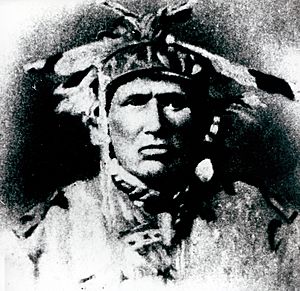Shingwauk facts for kids
Quick facts for kids
Shingwaukonse
|
|
|---|---|

Chief Shingwauk at Robinson Huron Treaty Signing in 1850
|
|
| Born | 1773 |
| Died | 1854 |
| Nationality | Ojibwe |
| Other names | Shingwauk, Little Pine, Zhingwaakoons, Shinguacouse |
| Occupation | Indigenous chief and warrior |
| Known for | Signatory to Robinson-Huron Treaty |
Shingwaukonse (also known as Zhingwaakoons or "Little Pine" in Fiero spelling) was an important Anishinaabe chief. He was born in 1773 and passed away in 1854. Shingwaukonse played a big part in creating the Garden River First Nation near Sault Ste. Marie, Ontario. He also signed the Robinson Huron Treaty in 1850.
Contents
Shingwaukonse's Family Life
Shingwaukonse was born in the Sault Ste. Marie area in 1773. We don't know his parents' names, but his mother was from the crane clan.
He had many children. Some of his sons became important leaders after him. Augustine (1800-1890) and Buhgwujjenene (1811-1900), also known as "Wildman," both served as chiefs of Garden River. Augustine was chief from 1854 to 1890, and Buhgwujjenene followed from 1890 to 1900. Shingwaukonse's youngest son, George Shingwauk (1838-1923), was also elected chief of Garden River First Nation for several years.
Shingwaukonse followed traditional Anishnaabe religion for most of his life. Around 1833, he became a member of the Anglican Church. He died in March 1854.
Shingwaukonse's Role in the War of 1812
Shingwaukonse was a brave leader and warrior during the War of 1812. He fought alongside the British in this war.
For his service, he received special awards, including a chief's medal. He also got a general military service medal. After the war, Lieutenant Governor Sir John Colborne gave him another medal. Because of his help, he was given the special title of "deserving chief." This meant he received good treatment and gifts from the government during important discussions.
Shingwaukonse's Leadership for Indigenous Rights
After the War of 1812, Shingwaukonse had a clear idea for his community. He wanted Indigenous people to have their own rights and control over their lives. He believed in sharing resources with European settlers in a way that would help the people of Garden River. He also wanted a relationship with the government that allowed his people to be independent.
Shingwaukonse spoke up for land rights. For example, he took part in the Mica Bay Incident. This was a protest against a mining company that was using their land.
Shingwaukonse's Push for Education
Shingwaukonse strongly believed that education was key for the Anishnaabe people. He wanted them to keep their language and culture alive. In 1832, he traveled a long way by snowshoe from Sault Ste. Marie to York (which is now Toronto). He went to ask Governor John Colborne to send a teacher for his community.
He also dreamed of creating a "Teaching Wigwam Lodge." This would be a place where his people could learn to read and write in English. His goal was for them to get an education while still holding onto their traditions and culture. Shingwaukonse's vision eventually led to the creation of Shingwauk Kinoomaage Gamig in 2008.

